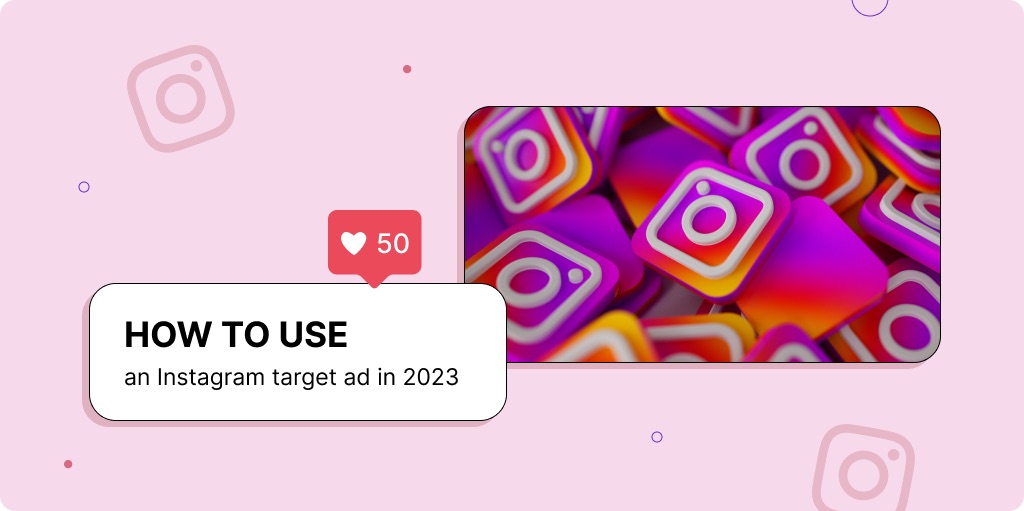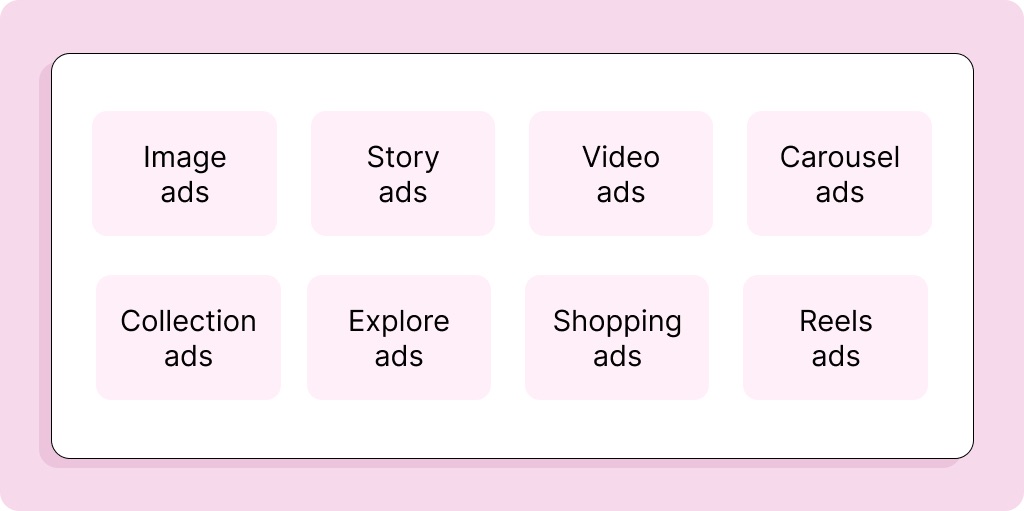 Nailing the Price Change Talk: Effective Messaging Strategies, Tips & Templates
Nailing the Price Change Talk: Effective Messaging Strategies, Tips & Templates
Learn how to effectively communicate price changes to your customers with our expert tips. Balance customer trust and loyalty while scaling your business!

If you have a paid social media marketing budget, you should seriously consider running Instagram advertisements. Why? 96.6% of Instagram’s active user base is reached via ads each month. That equates to over 2 billion potential clients! Yet the target demographic is still expanding; according to Meta data, Instagram’s ad reach has increased by 21% in the last year, despite changes in ad reporting. This post will show you how to advertise on Instagram, including a simple 8-step process for making your first Instagram ad.
Instagram advertisements are postings that companies may pay to be served to particular target audiences on Instagram. These advertisements show in the same manner as organic material from other Instagram accounts in users’ feeds, Stories, and explore pages. Instagram advertisements might include photos, videos, carousels, or collections.
Instagram ads resemble regular posts but always have a Sponsored label to clarify that they are advertisements. They also typically have additional elements than a standard post, such as links, CTA buttons, and product tags.
The cost of Instagram advertisements is determined by your overall budget, length, and campaign objectives. You may establish a daily or lifetime budget for your Instagram advertisements, so the amount you pay is entirely up to you. There is no best practice for how much money to spend, but Meta suggests starting with at least $5.00 every day.
While there is no such thing as an average or benchmark price, several cost considerations may include:
Marketers may specify their maximum bids for each auction, or Instagram will automatically optimize them. Hence, if you’re new to advertising on Instagram, it’s advisable to start with a low maximum bid.
After you’ve gotten a better understanding of the competitive environment for your selected sector and demographics, you may evaluate whether upping your maximum offer is required. We’ll go over this in greater depth in our 8-step tutorial below.
The best way to evaluate your budget is to create a draft campaign in Instagram Ad Manager and check for the Audience Definition and Estimated Daily Results modules. This will tell you if your spending settings will be sufficient to reach your targeted audiences within the campaign length you selected.
 Because of the variety, you may select the ideal ad kind for your unique company objectives. Six campaign objectives have been made simpler for Instagram ads. Call-to-action possibilities will vary based on the ad type and goal you decide on.
Because of the variety, you may select the ideal ad kind for your unique company objectives. Six campaign objectives have been made simpler for Instagram ads. Call-to-action possibilities will vary based on the ad type and goal you decide on.
Campaigns with engaging visual content that can be communicated in a single image are best suited for Instagram image ads. High-quality photography, as well as design and art, may be used to produce these pictures. Text may also be added to an image. Instagram, on the other hand, suggests reducing overlay text for accessibility and the best outcomes.
Instagram video ads are an excellent method to present your product or service in a captivating and eye-catching manner. You may use video ads to illustrate how items function, highlight special features, or just tell the narrative of your company. In-feed video ads can last up to 60 minutes, although shorter ones are generally more successful.
Full-screen image or video ads that display between users’ Stories are known as Instagram Story Ads. With over 500 million Instagram users seeing Stories every day, Instagram Stories are a popular feature of the platform. Because Stories ads fill the entire mobile screen and are far more immersive than in-feed ads, engagement is generally greater.
The most effective Instagram Stories ads blend in with regular Stories and don’t stick out as ads. All organic Instagram Stories elements, such as filters, text, GIFs, and interactive stickers, may be used by businesses when building Stories ads. Still, images, videos, and carousels may all be used in Stories ads. At the bottom of the story, the CTA is given as a swipe-up link.
Carousel ads on Instagram allow viewers to swipe through a collection of photos or videos. With a call-to-action button or swipe-up link that directs viewers to your website, they may appear both in the stream and within Instagram Stories.
Carousel ads can be used for:

Carousel ads and shopping ads are combined in Instagram collection ads. Ads for collections feature goods from your product catalog. Collection ads are best suited for eCommerce firms since they enable visitors to buy things right from the ad. A person who clicks on the ad is sent to an Instagram Instant Experience Storefront where they can learn more about the product and buy it.
Explore ads appear on the Explore tab, where users may discover new content and accounts based on their Instagram usage patterns. Instagram Explore ads do not display in the Explore grid or topic channels but rather when a user clicks on an Explore photo or video.
Because the content in viewers’ Explore tabs is continuously changing, Explore ads enable companies to be displayed alongside culturally relevant and popular content. Both photos and videos can be used as Explore ads.
Instagram has provided the opportunity to promote inside Reels following the successful debut of the app. Ads are broadcast in between Reels and can last up to 60 seconds, similar to Story ads.
To be well-integrated, they should contain sound or music. A Sponsored mark will appear beneath the account name in all Instagram Reels ads. These ads will cycle indefinitely if not stopped. Users may also like, share, comment, and bookmark your Own ads.
With 44% of Instagram users shopping on the site every week, it’s no surprise that Instagram’s eCommerce tools have improved significantly over the past 1-2 years. Instagram’s Shopping capabilities allow users to see and buy things without leaving the app.
Instagram Shopping ads send viewers to a product detail page inside the Instagram app. Consumers may then make a purchase using your mobile website. You must set up your Instagram Shopping catalogue in order to run Shopping ads.
There are two ways to create Instagram ad campaigns: by boosting an existing post or by establishing a new ad in the Facebook Ads Manager, known as the Meta Ads Manager. Promoting an existing post is simple and can be done directly from the Instagram app, although it lacks the personalization possibilities found in Instagram Ads Manager.
Promoting one of your current posts is the simplest method to begin advertising on Instagram. This is comparable to Facebook’s Boost Post feature. If you have a post that is performing well in terms of interaction, advertising it within the app is a quick and easy way to scale its success and promote it to new people who aren’t already following you.
To achieve this, you will need an Instagram business or creator account. Also, you must link your Instagram account to a Facebook Business Page. Next, just click Boost post on the post you want to make into an ad.
Next, decide on an objective. You’ll have three choices: more profile views, more website visits, or more communications (including WhatsApp messages). Then, define your audience. Instead, you may let Instagram estimate your audience based on your following statistics. You may also design your own audience by inputting your targeting variables manually. If you choose, you may also select to run the boosted post on Facebook.
Choose your daily budget and the length of time you want the ad to run. You may either set a time limit or let it continue indefinitely until you actively halt it. Lastly, when you’re ready to go live, evaluate your ad and click Boost submit. That’s all! Facebook will examine and approve your ad. Under the Promotions section of your Instagram profile, you can track your ad’s performance once it goes live.
To make the most of Instagram’s sophisticated ad targeting, creative, and reporting capabilities, you may construct ad campaigns using the Meta Ads Manager; keep in mind that Meta is the company that owns Instagram.
Step 1: Launch a new Instagram ad campaign
To begin, go to Meta Ads Manager and click +Create.
Step 2: Choose your goal
You may connect your ad with an existing campaign or create a new one from scratch. To begin a new campaign, you must first select a goal.
In Instagram ads, there are six campaign objectives:
Select the objective that best suits your objectives and click Proceed.
Step 3: Name the campaign
After the selection of your aim, you will be invited to name your campaign. Give it a name depending on the campaign aim to help you keep track of your campaigns. Once you’ve decided on a name, select Next.
Step 4: Decide on a budget and schedule
When you’ve decided how you want your ad to look, select New [your ad purpose here]. Choose Ad Set from the menu on the left. You may choose how much money you want to spend and how long your campaign will run here.
You will have two budget options:
Under Ad Scheduling, you may opt to display ads constantly or only at specific times of day; for example, if you’re a food delivery company, you might only want to broadcast ads in the evening when your audience is most likely to request delivery.
When you change these settings, the Audience Definition and Expected Daily Results modules will appear in the right-hand column, giving you a sense of your budget’s intended reach.
Step 5: Identify an audience
Now it’s time to select your audience. You may either use an existing audience or create a new one. Saved Audiences are beneficial if you have your own unique audience data or historical audiences from successful campaigns.
If not, you may build a new audience based on demographics, interests, and behavioural tracking. If you build a new audience, you may target by region, age range, gender, demographics, interests, behaviours, and languages.
Step 6: Select an Instagram ad placements
You may choose where your ads will appear in the Placements section.
There are two options:
We suggest Advantage+ placements if you’re new to Instagram advertising. The Ads Manager will provide you with the technical requirements for each manual placement if you select it.
Step 7: Create a new Instagram ad
It’s time to construct your new Instagram advertisement. Choose the New [your objective here] Ad from the left-hand menu. You may personalize your new Instagram ad on the screen that appears after clicking this.
You may change the name of your ad, select multiple Instagram ad kinds, and add creative components such as images, videos, headlines, and CTAs. You may also add any content, website links, and tracking parameters on this screen.
Choose the Facebook Pixel in the Tracking area if you want to monitor conversions from your ad. Once linked to your website or app, your Facebook pixel will provide you with information on how your audience interacts with your company after clicking on your ad.
Step 8: Publish an Instagram ad
When you’ve completed all of the required information, click Publish in the bottom right-hand corner of your screen. The budget and timing you selected will now be used for your Instagram ads. To monitor how your ads are performing, be sure to check your Instagram Analytics on a frequent basis.
You now have all the information you require to set up and begin Instagram ads. The next stage is to create excellent graphic elements for your ads. Designing eye-catching creative for Instagram ads? Here are some pointers.
More than 4.08 billion people visit social media via mobile devices; thus, it’s critical to build your content for mobile viewing rather than desktop viewing.
Here are some pointers for creating mobile-first ads:
The opening few seconds of your advertisement will influence whether or not a reader will stop scrolling and watch the entire thing. That is why it is critical to begin your ad with the primary message and display your trademark within the first three seconds.
According to data, 69% of social media users watch without sound. As a result, it’s critical to design your ads for sound-free consumption and to employ sound to satisfy viewers who do have sound on.
Here’s how you do it:
Facebook suggests creating a mix of creative kinds that work together to capture attention and reward interest:
With so many Instagram ad kinds to select from, you can test different combinations of pictures and messages to see which ones work best for your target demographic. Try combining carousel posts, collections, shoppable posts, video ads, and Story ads into your advertising strategy.
Also, be creative! Why not try some meme ads, customized artwork, or GIFs to get your point across? Note that the look and style of your brand should be reflected in your Instagram ads. Yet, there’s no reason why you shouldn’t mix things up to keep your audience interested.
The easiest approach to determine whether your Instagram ads are effective is to assess their efficacy with analytics. Instagram’s native reporting tool provides information on critical metrics, including impressions, clicks, engagement rate, and ROI. You may also utilize third-party tools to track your campaign success in greater detail and make data-driven choices on how to improve future ad campaigns.